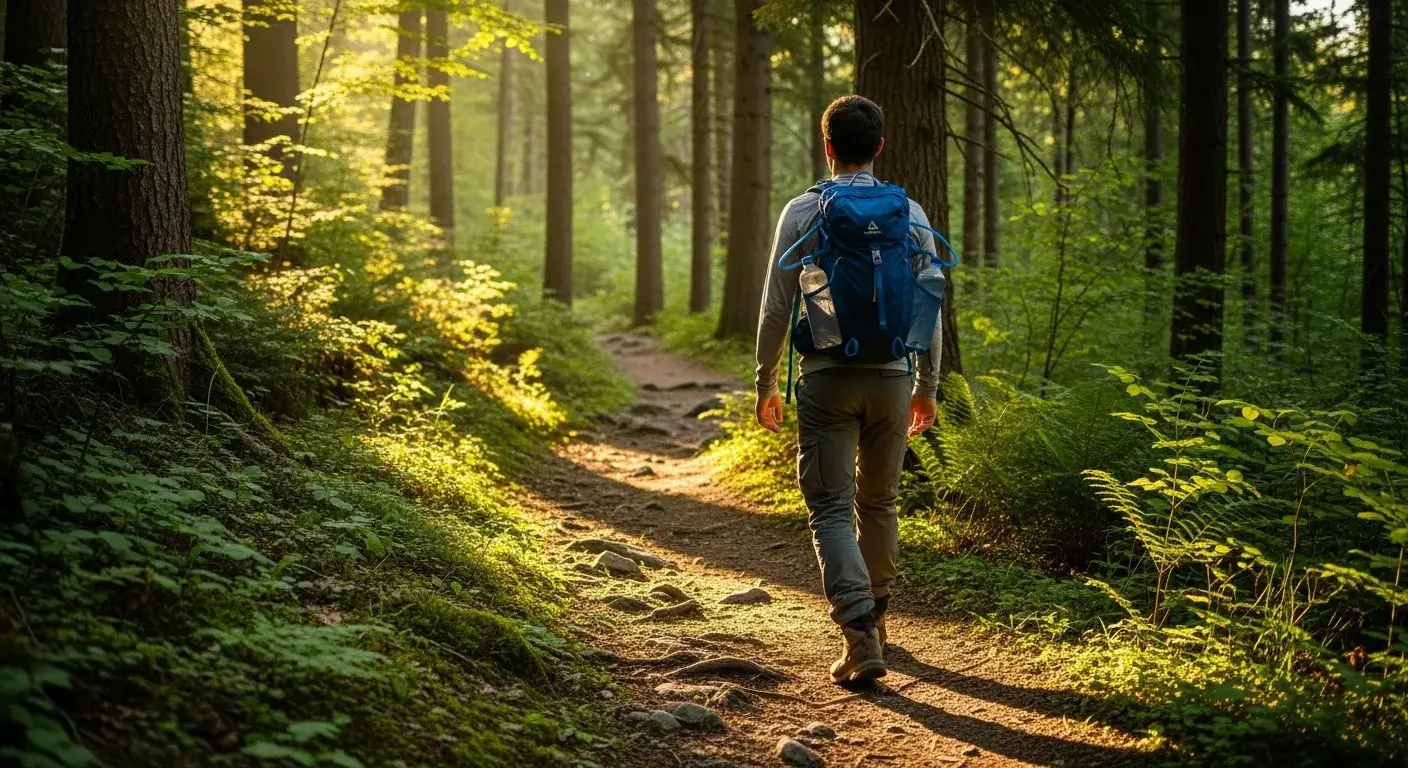
You're planning your next day hike, but you're unsure how much water to pack. Too little water leads to dangerous dehydration. Too much water makes your pack unnecessarily heavy.
For most day hikes, carry 0.5-1 liter of water per hour of hiking. A typical 4-6 hour moderate hike requires 2-3 liters minimum, increasing to 4-6 liters in hot weather or challenging terrain.
The right amount of water keeps you safe and energized on the trail. This guide helps you calculate your exact water needs for any day hike.
What Factors Influence How Much Water You Need on a Day Hike?
Your water needs depend on several key factors beyond basic recommendations. Understanding these variables helps you pack the right amount for safe hiking.
Temperature, terrain difficulty, your body weight, altitude, and hike duration all significantly impact your water requirements. Hot weather can double your needs from 0.5L to 1L per hour.
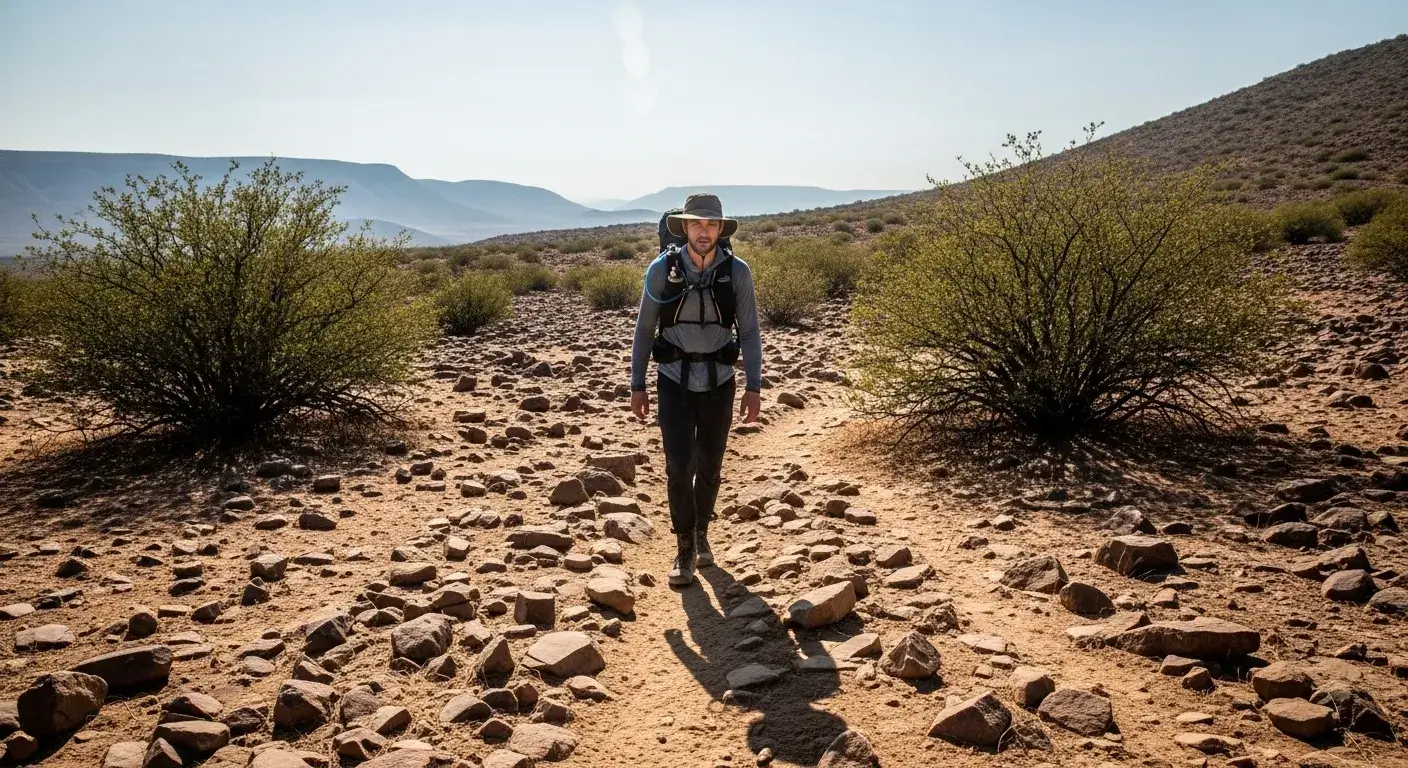
Temperature Makes the Biggest Difference
Hot weather dramatically increases your water needs. In moderate conditions (50-70°F), you need about 0.5 liters per hour. When temperatures climb above 80°F, your sweat rate doubles. You'll need up to 1 liter per hour to stay hydrated.
Cold weather tricks many hikers. You feel less thirsty, but you still lose water through breathing and light sweating. Cold air holds less moisture. This makes you lose water faster through your lungs. Even in winter, aim for 0.4-0.6 liters per hour.
Your Body Weight and Fitness Level Matter
Larger people need more water. A 200-pound hiker loses more fluid than a 120-pound hiker doing the same activity. Use this simple rule: multiply 0.016 liters by your body weight in pounds. Then multiply by hours hiked. This gives your baseline water needs.
Fit hikers have an advantage and disadvantage. They sweat more efficiently to cool down. But they also start sweating sooner. If you're new to hiking, your body hasn't adapted yet. You might need 10-20% more water until you build fitness.
Terrain and Altitude Create Hidden Challenges
| Factor | Water Increase | Reason |
|---|---|---|
| Steep uphill | +25% | Higher heart rate and breathing |
| Very steep terrain | +50% | Maximum exertion level |
| Above 5,000 feet | +20% | Dry air increases water loss |
| Above 8,000 feet | +30% | Rapid breathing in thin air |
Altitude affects everyone differently. The air gets drier as you climb higher. Your breathing rate increases. You lose an extra 1-1.5 liters of water daily at 8,000 feet compared to sea level. Start drinking extra water the day before high-altitude hikes.
Pack Weight and Duration Add Up
Every liter of water weighs 2.2 pounds. Heavy packs make you work harder. This increases your sweat rate. Plan for this extra effort when calculating water needs.
Long hikes need buffer water. Add an extra 0.5-1 liter for delays or emergencies. Getting lost or taking long breaks extends your time on trail. This buffer prevents running out of water in unexpected situations.
How Do You Calculate Water Requirements for Different Hike Lengths and Terrains?
Use a simple formula to determine your exact water needs. Start with base requirements, then add adjustments for conditions and personal factors.
Base formula: (Hike hours × 0.5-1L per hour) + terrain adjustments + weather adjustments + 0.5L buffer. Always round up for safety.
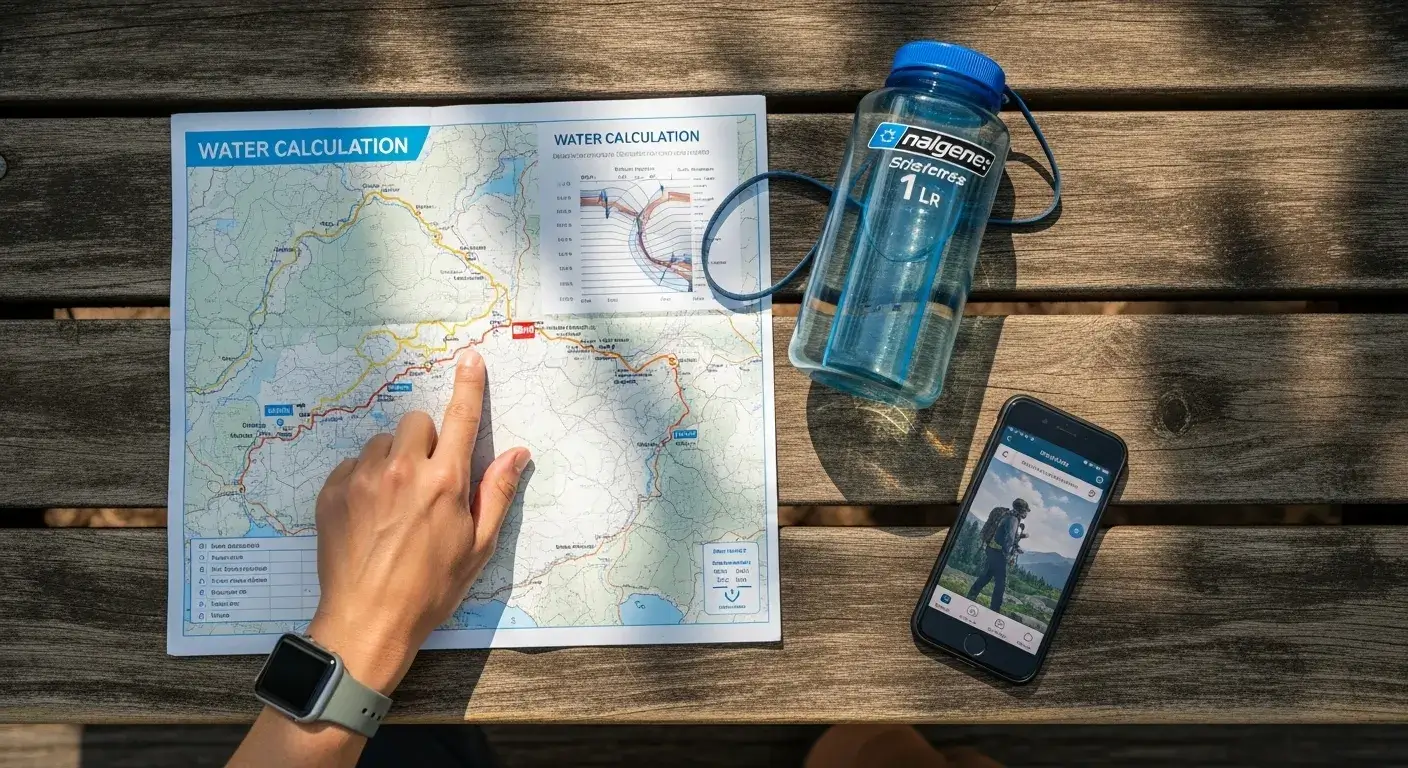
The Basic Calculation Method
Start with your planned hiking time. Multiply by 0.5 liters for easy terrain in cool weather. Use 1 liter per hour for hot weather or difficult terrain.
Example calculations:
- 4-hour easy hike, cool weather: 4 × 0.5L = 2L base
- 6-hour moderate hike, warm weather: 6 × 0.75L = 4.5L base
- 8-hour challenging hike, hot weather: 8 × 1L = 8L base
Distance-Based Rules for Quick Estimates
Some hikers prefer distance-based calculations. Use 1 liter per 2-3 miles for moderate terrain. This assumes a 2-3 mph hiking pace.
For a 10-mile moderate hike:
- 10 miles ÷ 2.5 miles = 4 hours estimated time
- 4 hours × 0.75L = 3L base water needs
Adjustments for Challenging Conditions
Add these percentages to your base calculation:
Terrain Adjustments:
- Rolling hills: +15%
- Steep sections: +25%
- Very steep or technical: +50%
Weather Adjustments:
- Hot (80°F+): +50-100%
- Very hot (90°F+): +100%
- High humidity: +25%
- Windy conditions: +15%
Testing Your Personal Sweat Rate
The most accurate method is testing your personal sweat rate. Weigh yourself naked before a 1-hour hike. Weigh again immediately after. Don't drink or use the bathroom during the test.
Each pound lost equals 0.5 liters of sweat. Multiply by 1.25 to get your replacement needs. This accounts for continued sweating and optimal hydration.
Example: You lose 2 pounds in one hour = 1 liter sweat loss. You need 1.25 liters per hour replacement water.
Is 2 Liters Enough for a Typical Day Hike, or Do You Need More?
Two liters works for short, easy hikes in cool weather. Most day hikers need 3-4 liters minimum for adequate hydration and safety margins.
Two liters covers 2-4 hours of easy hiking in temperatures below 70°F. For typical 4-6 hour day hikes, carry 3-4 liters minimum, increasing to 5-6 liters in hot weather.
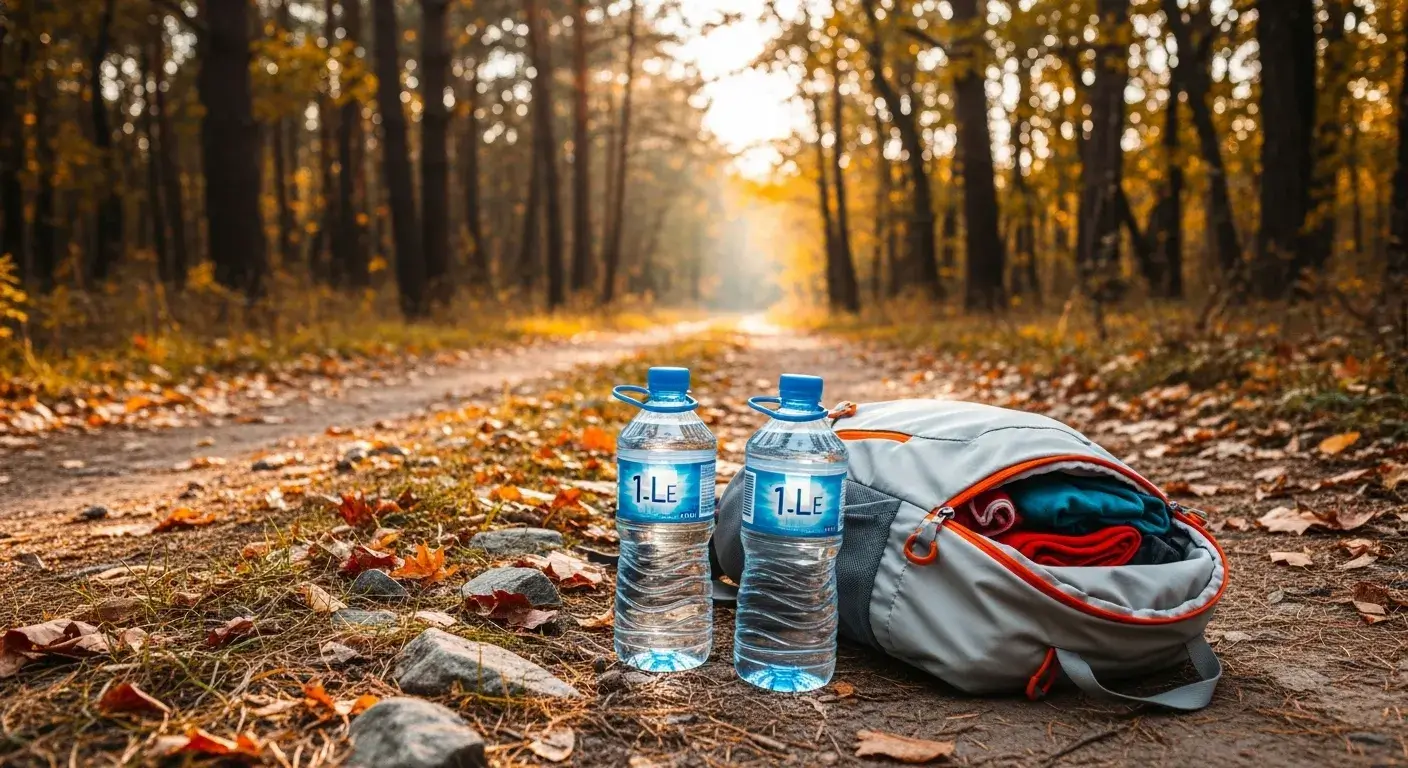
When 2 Liters Is Sufficient
Two liters works well for these conditions:
- Hikes under 4 hours
- Easy, flat terrain
- Cool weather (under 70°F)
- Reliable water sources for refilling
- Experienced hikers who know their needs
Many popular trail guides suggest 2 liters as a baseline. This assumes moderate conditions and average fitness levels. It doesn't account for variables that increase your needs.
Why Most Hikers Need More Than 2 Liters
Real-world hiking rarely matches ideal conditions. Weather changes during the day. Trails prove more challenging than expected. You might hike longer than planned.
A 6-hour moderate hike needs 3-4.5 liters at minimum. Add another 1-2 liters for hot weather. This explains why experienced hikers often carry 4-6 liters for full-day adventures.
The Risk of Carrying Too Little
Dehydration symptoms start1 with just 2% body water loss. For a 150-pound person, this is only 1.5 liters. Symptoms include:
- Fatigue and reduced energy
- Headaches
- Difficulty concentrating
- Reduced hiking performance
Severe dehydration becomes dangerous quickly. Dark urine, dizziness, and rapid heartbeat signal serious problems. Prevention is much easier than treatment on the trail.
Balancing Weight vs. Safety
Every liter adds 2.2 pounds to your pack. This creates a difficult balance between safety and comfort. Smart strategies help minimize weight:
- Map water sources and plan refills
- Carry water purification tablets or filters
- Start extra-hydrated to reduce carrying needs
- Share group water supplies when possible
How Can You Stay Hydrated in Hot, Cold, or High-Altitude Conditions?
Extreme conditions demand special hydration strategies. Hot weather, cold temperatures, and high altitude each present unique challenges requiring different approaches.
In hot weather, drink 1L per hour with electrolytes. Cold weather requires 0.5L hourly despite reduced thirst. High altitude increases needs by 20-30% due to rapid breathing.
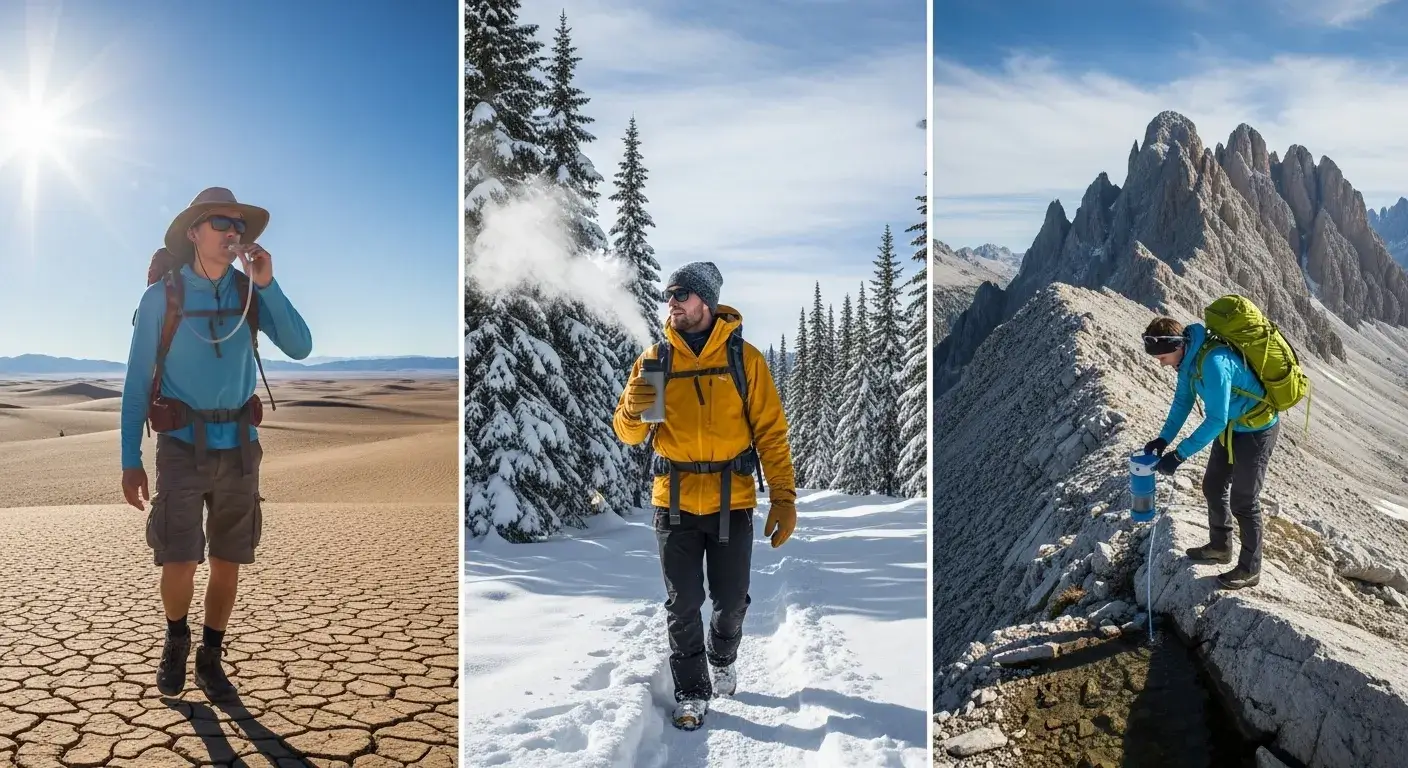
Hot Weather Hydration Strategies
Hot weather hiking is dangerous without proper hydration. Your sweat rate can reach 2-3 liters per hour in extreme heat. Plain water isn't enough for extended hot weather hiking.
Electrolyte Management:
Hot weather depletes sodium, potassium, and magnesium through sweat. Add 200-500mg of sodium per hour through:
- Electrolyte tablets (Nuun, Liquid IV)
- Sports drinks
- Salty snacks like pretzels or nuts
- Electrolyte powders
Drink before you feel thirsty. Thirst lags behind your actual hydration needs by 15-20 minutes. Sip small amounts every 10-15 minutes rather than chugging large quantities.
Cold Weather Hydration Challenges
Cold weather creates a dangerous illusion. You feel less thirsty, but you still lose significant water. Cold air holds less moisture. You lose extra water through breathing. Heated indoor air before hikes also dehydrates you.
Cold Weather Tactics:
- Carry insulated bottles to prevent freezing
- Drink warm liquids when possible
- Eat foods with high water content
- Monitor urine color since thirst is unreliable
Your breathing rate often increases in cold air. This leads to "insensible" water loss through your lungs. You might not notice this loss, but it adds up over long winter hikes.
High-Altitude Hydration Needs
Altitude affects everyone differently, but higher elevations always increase water needs. The air gets drier as you climb. Your breathing rate increases in thin air. Your kidneys work harder and produce more urine.
Altitude Effects on Hydration:
| Elevation | Extra Water Needed | Primary Cause |
|---|---|---|
| 5,000-8,000 ft | +20% | Dry air, slight breathing increase |
| 8,000-12,000 ft | +30% | Rapid breathing, increased urination |
| 12,000+ ft | +40% | All effects maximized |
Start extra hydration 24-48 hours before high-altitude hikes. Your body needs time to adapt. Avoid alcohol and limit caffeine, which both promote dehydration.
Universal Extreme Condition Tips
Regardless of conditions, certain strategies always help:
Pre-hydration Protocol:
- Drink 16-20 oz two hours before hiking2
- Continue sipping until urine runs pale yellow
- Avoid excessive water right before starting
During-Hike Monitoring:
- Check urine color at breaks
- Monitor energy levels and mood changes
- Watch for early dehydration symptoms
- Adjust intake based on conditions
Recovery Hydration:
- Drink 150% of estimated fluid losses post-hike
- Include electrolytes and protein
- Monitor overnight for adequate rehydration
What Are the Best Ways to Carry and Purify Water on the Trail?
Carrying and purifying water efficiently keeps you hydrated without overloading your pack. Choose the right combination of containers, purification methods, and refill strategies.
Use hydration bladders for convenient sipping and bottles for easy refilling. Carry lightweight filters like Sawyer Mini for reliable water purification from natural sources.
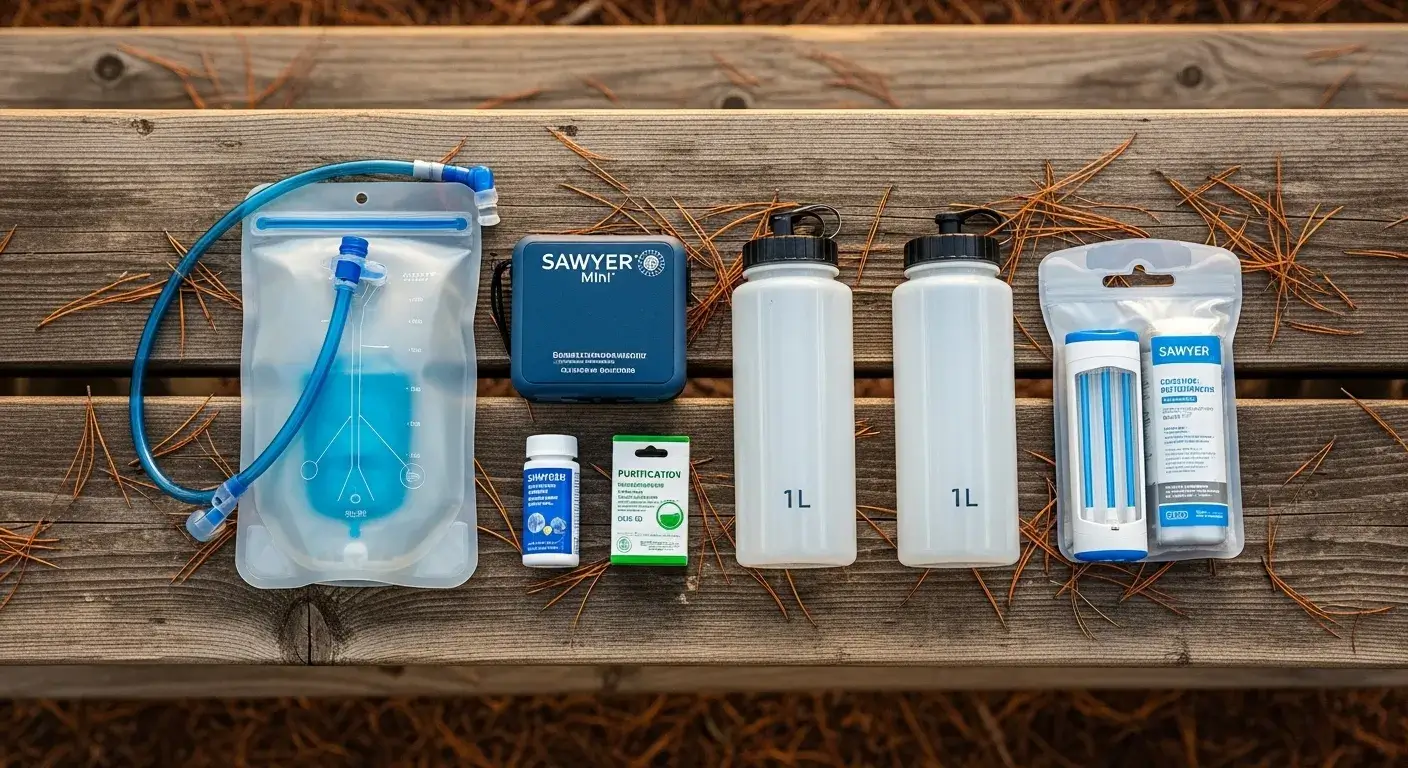
Water Carrying Systems Compared
Hydration Bladders (2-3L capacity):
- Hands-free drinking through tube
- Even weight distribution in pack
- Easy to drink frequently
- Harder to monitor consumption
- Difficult to refill on trail
Water Bottles (1L each):
- Easy to refill and clean
- Simple to monitor intake
- Durable and reliable
- Must stop to drink
- Takes up pack space
Hybrid System (Recommended):
Carry one 2L bladder plus one 1L bottle. Use the bladder for regular sipping. Keep the bottle for refills, electrolyte mixing, and backup. This gives flexibility with reasonable weight.
Water Purification Methods
Never drink untreated water from natural sources. Even clear mountain streams can contain harmful bacteria, viruses, and parasites3.
| Filter Systems: | Filter Type | Weight | Capacity | Best Use |
|---|---|---|---|---|
| Sawyer Mini | 2 oz | 100,000 gallons | Day hikes, backup | |
| LifeStraw | 2 oz | 1,000 gallons | Personal emergency | |
| Katadyn Hiker Pro | 11 oz | 750 gallons | Group hiking |
Chemical Purification:
- Aquatabs: Light, effective, 30-minute wait time
- Iodine tablets: Reliable, leaves taste
- UV sterilizers: Fast, requires clear water
Boiling Water:
Always effective but requires stove and fuel. Boil for 1 minute at sea level, 3 minutes above 6,500 feet4. Good for cooking water but impractical for drinking water only.
Smart Refill Strategies
Plan water sources before hiking. Use apps like AllTrails, FarOut, or Guthook to identify reliable water sources. This reduces carrying weight significantly.
Water Source Evaluation:
- Fast-flowing streams: Usually safer than stagnant water
- Higher elevation sources: Generally cleaner
- Avoid water near campsites or grazing areas
- Never trust water downstream from roads
Carry 70% of estimated needs and plan to purify 30% from sources. This balances safety with pack weight. Always have backup purification methods.
Weight Distribution and Pack Balance
Water weight affects hiking comfort and safety. Poor distribution causes back pain and instability.
Optimal Water Placement:
- Heavy bladder: Center of pack, close to back
- Bottles: Side pockets or front chest pockets
- Backup water: Bottom of pack
- Keep weight balanced left-to-right
Consider your hiking style when choosing systems. Fast hikers benefit from hands-free bladders. Photographers and break-takers prefer bottles for easy access.
What Are the Signs of Dehydration and How Can You Prevent It?
Recognizing dehydration early prevents serious health problems on the trail. Learn the warning signs and prevention strategies to stay safe during any hike.
Early dehydration signs include thirst, dark urine, fatigue, and headaches. Prevent dehydration by drinking before thirst, monitoring urine color, and sipping every 15-20 minutes.
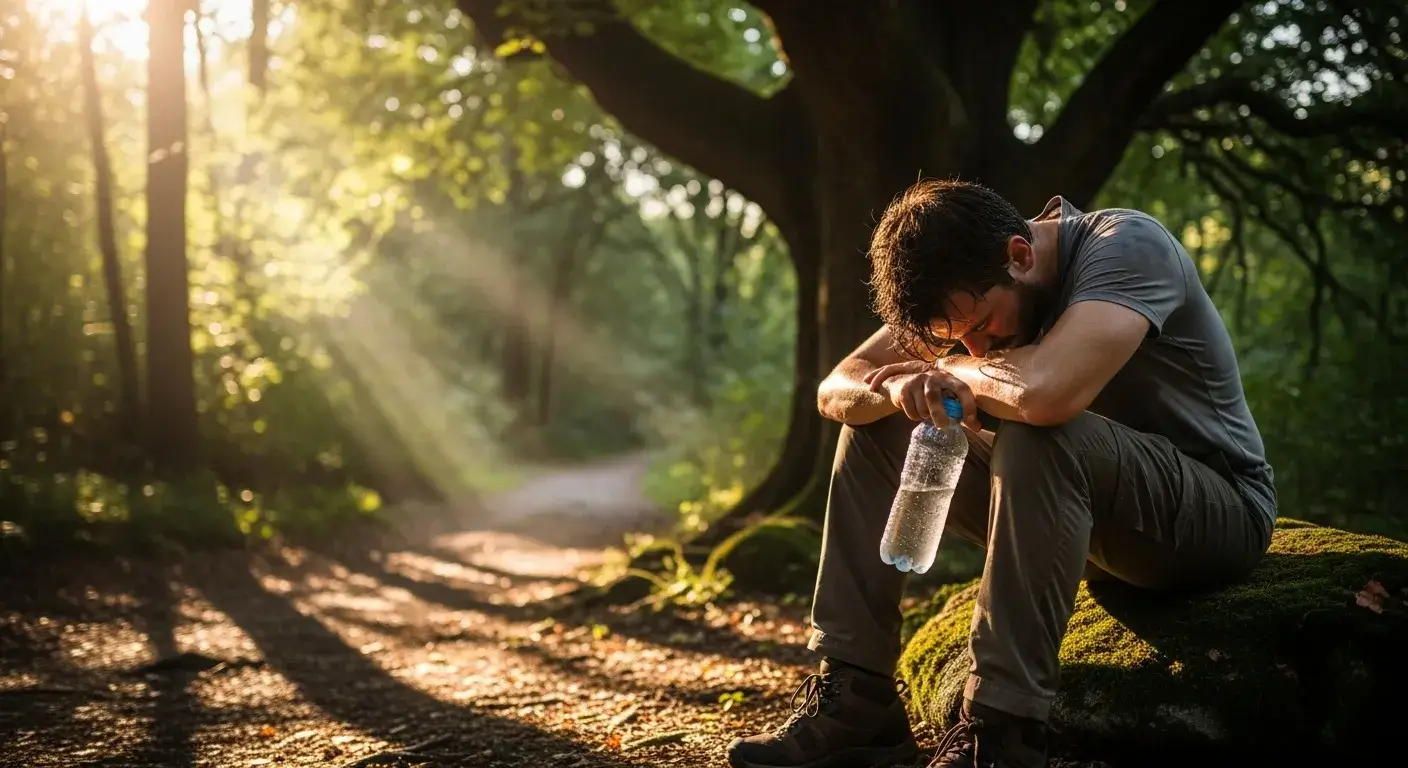
Progressive Dehydration Symptoms
Dehydration develops in stages. Early recognition allows easy treatment. Waiting too long creates dangerous situations requiring emergency care.
Mild Dehydration (2-5% fluid loss):
- Increased thirst sensation
- Slightly dark urine (dark yellow)
- Mild fatigue or tiredness
- Slight reduction in hiking pace
Moderate Dehydration (5-10% fluid loss):
- Strong thirst with dry mouth
- Very dark urine or no urination
- Noticeable fatigue and weakness
- Headache and mild dizziness
- Irritability or mood changes
Severe Dehydration (10%+ fluid loss):
- Little to no urine production
- Rapid or weak pulse
- Confusion or altered mental state
- Severe weakness or inability to hike
- Signs of heat exhaustion or heat stroke
The Urine Color Chart Method
Urine color provides the most reliable dehydration indicator5. Check your urine color at every bathroom break during hikes.
Hydration Status Guide:
- Pale yellow (lemonade): Well hydrated
- Yellow (beer): Adequate hydration
- Dark yellow (apple juice): Mild dehydration
- Orange/brown: Severe dehydration - drink immediately
Take a photo of your urine against white toilet paper for accurate color assessment. Certain vitamins and medications affect urine color. B-vitamins create bright yellow urine even when well-hydrated.
Prevention Strategies That Work
Pre-Hike Hydration:
Start hydrating 24 hours before big hikes. Drink an extra 16-32 oz the day before. Have 16-20 oz two hours before starting. This pre-loading reduces your carrying requirements.
During-Hike Prevention:
- Set phone alarms every 15-20 minutes to drink
- Sip small amounts frequently vs. large quantities occasionally
- Drink before feeling thirsty
- Include electrolytes for hikes over 2 hours
- Rest in shade during hot weather
Environmental Awareness:
Monitor weather forecasts and adjust plans accordingly. Hot, humid days require more frequent breaks and increased water intake. Wind increases dehydration through evaporation. High altitude affects everyone differently.
Treatment for Mild to Moderate Dehydration
Catch dehydration early for easy treatment. Advanced dehydration requires medical attention and possibly evacuation.
Immediate Treatment Steps:
- Stop hiking and find shade
- Sip water slowly - don't chug
- Add electrolytes if available
- Rest for 15-30 minutes
- Monitor symptoms before continuing
When to Call for Help:
- No improvement after 30 minutes of treatment
- Confusion or altered mental state
- Inability to keep fluids down
- Signs of heat stroke (hot, dry skin with high body temperature)
Group Monitoring:
Watch hiking partners for dehydration signs. People often don't recognize their own symptoms. Create a buddy system for longer or more challenging hikes. Check in regularly about water intake and energy levels.
Recovery from mild dehydration typically takes 30-60 minutes with proper treatment. Severe cases may require hours or medical intervention. Prevention remains much easier than treatment on remote trails.
Conclusion
Proper hydration planning keeps you safe and comfortable on day hikes. Calculate 0.5-1L per hour based on conditions, carry appropriate equipment, and monitor hydration status throughout your adventure.
-
Comprehensive medical resource explaining dehydration symptoms, causes, and when symptoms begin affecting physical and cognitive performance during outdoor activities. ↩
-
Official evidence-based guidelines from the American College of Sports Medicine providing specific fluid intake recommendations before, during, and after exercise to maintain optimal hydration status. ↩
-
Authoritative CDC resource detailing waterborne pathogens found in natural water sources and comprehensive water treatment methods for hikers and campers to prevent illness. ↩
-
CDC guidelines on proper water sterilization techniques, including boiling times at different elevations to ensure complete elimination of disease-causing organisms in backcountry water. ↩
-
Medical information about using urine color as a practical field indicator for hydration status, helping hikers monitor their fluid needs during outdoor activities. ↩

